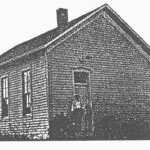Jonathan Jennings came to the Indiana Territory from Pennsylvania in 1807, at the age of 23, eager to prove himself on what was then the western frontier. He settled in Vincennes, was admitted to the practice of law, and immersed himself in both local and territorial politics. A political contretemps over the newly established Vincennes University caused Jennings to seek a fresh start just a year later, in 1808, when he relocated to Clark County.
It was after that move that he became the territory’s antislavery candidate for Congress. Although slavery was banned in the Northwest Territory, there was a strong pro-slavery faction in Vincennes led by territorial Governor William Henry Harrison (in office 1801-1812).
Jennings cast his lot with the anti-slavery faction; his campaign opponent was Thomas Randolph, a close friend of Gov. Harrison and himself an ardent proslavery advocate. In addition to disagreeing on slavery, the two men had very different campaign styles: whereas Randolph might ride up to a farm, stop, and wait to address the men until after they had quit for the day, Jennings would join in the farmers’ work and befriend them. After quitting time, he talked politics with them and played sports—“always being careful to let the men defeat him”.
Jennings won the election and was seated in Congress as a delegate from the Indiana territory on November 27, 1809. He would be reelected to that post in 1811, 1812, and 1814, always taking care to put the needs of his constituents first, and sometimes clashing with Governor Harrison.
“In December, 1815, Jennings presented a petition from the territorial Legislature asking that statehood be granted. The census taken that year had shown a population of over sixty-three thousand, which was more than the Ordinance of 1787 required”. Congress granted the request in 1816; Jennings was elected a delegate to the constitutional convention, where his fellow delegates chose him to preside over the convention.
That same year, Jennings and Thomas Posey both emerged as candidates for the new state’s first governorship. Posey had served as territorial governor since 1813, but he was not especially popular and he suffered from health problems that hampered his ability to travel.
Jennings, on the other hand, enjoyed visibility and what today we would call name recognition—in addition to being a masterful politician. He still campaigned in his original style, since the voters of the day opposed outright electioneering, so “his activities had to be disguised as much as possible. When he dropped in at a meeting, militia muster, or log rolling, he was always ‘on his way’ to some other place”. Jennings won the state’s first governor’s race by a wide majority.
Still only in his early 30s, Jennings guided Indiana’s journey into statehood with a sure hand. He saw to it that the legislature established a judicial branch, an educational system that ranged from common schools to a state university, restrictions on the capture of free blacks, and a state library, among other initiatives. Jennings was reelected to a second term, but resigned 1822 in order to run for Congress when a seat opened up. During his tenure in Congress he helped ensure that the national road came through Indiana and Illinois.
Unfortunately, years of unstinting public service took their toll on Jennings. His drinking habit—not uncommon for men of his day—began to affect his health. After losing the 1830 congressional election, he retired to his farm near Charlestown, where he died in 1834.
A Moment of Indiana History is a production of WFIU Public Radio in partnership with the Indiana Public Broadcasting Stations. Research support comes from Indiana Magazine of History, published by the Indiana University Department of History.
Source: Dorothy Riker, “Jonathan Jennings,” Indiana Magazine of History 28, no. 4 (Dec. 1932): 223-239.






















